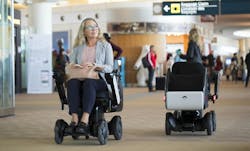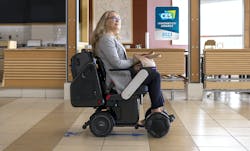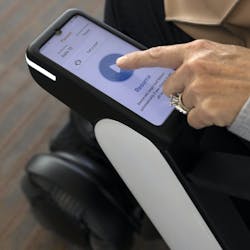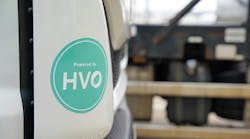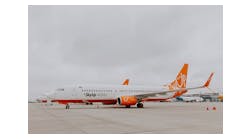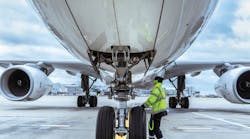With labor shortages and technology advancing rapidly, airports and airlines are striving for a “seamless travel” experience and finding ways to optimize the passenger's journey through the airport. The conventional reliance on manual push services has posed an issue, contributing to delays and putting strain on the airport and airline workforces. Autonomous is the answer to these challenges and offers freedom for passengers like we’ve never seen before.
Providing sufficient service to passengers with reduced mobility is one of the most common challenges affecting airports and airlines today. Everyone deserves an independent and stress-free airport experience. According to FACC, this demographic represents the fastest-growing segment in the airline industry; this has translated into an upsurge in wheelchair push demands, extended wait times, and staff injuries, all exacerbated by escalating operating costs and a tight labor market.
How Does Autonomous Mobility Service Effectively Work in Airports?
Navigating through an airport can be challenging, whether you have limited mobility or not. With autonomous mobility service, the device offers a simple way to reach your destination. The technology combines sensors and an easy-to-use interface so people of all abilities can operate it effectively.
Users simply select their destination on the user-friendly touch screen, and confirm that it’s the correct location, and the WHILL chair takes care of the rest. In some airports, the system is optimized to allow passengers to make additional stops at designated locations such as restrooms, shops and restaurants.
Safety is the industry’s top priority, so the WHILL autonomous chair has advanced obstacle detection systems and responsive controls, guaranteeing a safe, reliable travel experience. The mapping technology integrates with the existing airport infrastructure, making this a scalable solution for airports of all sizes.
Upon reaching the gate, users exit the chair and it autonomously returns to its home station, ready to assist another passenger in need. In addition, chairs can be dispatched to pick up passengers at arrival gates or assist between gates during layovers.
This service caters to a diverse group of passengers, allowing for a smooth airport experience for the elderly, those accustomed to wheelchair assistance, and individuals with limited mobility who cannot walk long distances due to physical constraints. The freedom and independence the service offers to travelers are unmatched and make a lasting impression on passengers.
Safety Measures for Automated Mobility Chairs
One of the questions we get most often is about the safety and efficacy of the system. I can only speak for WHILL’s rollout of autonomous mobility service, which has undergone years of meticulous safety testing and is compliant with regulations to guarantee the safety of passengers. The incorporation of these safety features is imperative in providing a reliable autonomous chair service in airports. Here are examples of safeguards employed for the autonomous chair service:
- Collision Avoidance: Autonomous chairs are equipped with sensors to detect and avoid obstacles in their path. These sensors provide real-time data to help the chair navigate safely and engage automatic brakes to avoid collisions.
- Path Planning and Mapping: The autonomous chair service pre-maps the airport's layout to ensure safe and efficient navigation. Path planning takes into account factors like passenger traffic, restricted areas and potential hazards.
- Emergency Stop Button: A prominent emergency stop button is provided for passengers to stop the WHILL autonomous chair in emergencies or unexpected situations.
- Redundancy and Backup Systems: Critical components of the autonomous chair system, such as sensors, control systems and power systems, have redundancy or backup mechanisms to ensure continued, uninterrupted operation.
- Monitoring and Supervision: The autonomous chair service has a monitoring system in place to remotely supervise and control the chairs, ensuring smooth operations and addressing any issues promptly.
The studies at Winnipeg (Manitoba), Haneda (Tokyo), and Narita (Tokyo) airports stand as a testament to WHILL’s successful autonomous mobility service. Passengers can take charge of their journey, move at their desired speed, and do not need to wait for manual assistance to get to their destination. Looking ahead, WHILL is announcing partnerships with two of the top 10 busiest airports in the US in Q1 of 2024.
Inclusive Air Travel
Autonomous mobility is here to stay and is only going to continue to grow in popularity in the next five years. Furthermore, it will become the standard for airports seeking to operate efficiently and reliably. The aviation industry is working hard to be more inclusive and offer accessible air travel for everyone. Autonomous service puts control in the hands of the passengers, and WHILL’s solution contributes to creating a safe and independent environment for all, regardless of ability.
The future is here and autonomy is redefining the essence of air travel. Now is the time to empower passengers, showcase an effective way to navigate the airport, and remove the pressure off of the current workforce. These movements are powerful and will change the aviation industry for the better.
Tres Izzard is President of WHILL Mobility Services North America, the leading developer and service provider of electric and autonomous mobility chairs. He is focused on increasing public accessibility by deploying autonomous personal transportation solutions and on-site fleet rental services in airports, hospitals, malls, convention centers, and entertainment and vacation venues across North America. Tres’s previous experience included senior-level executive positions at ION Media Networks, The Walt Disney Company/MovieBeam, Inc., and Sunbeam Corporation.
